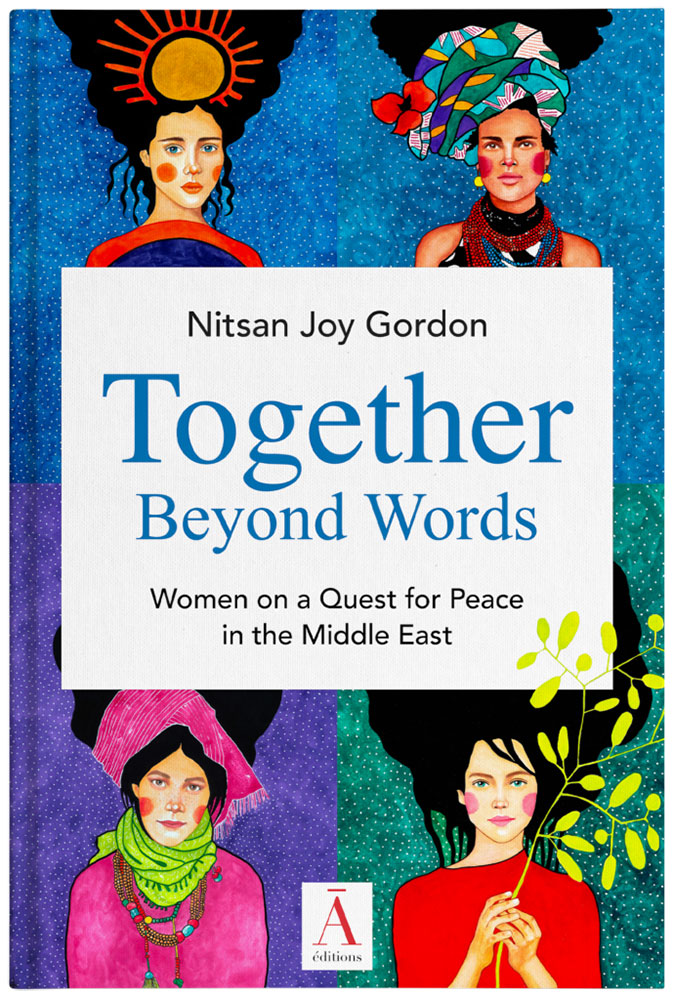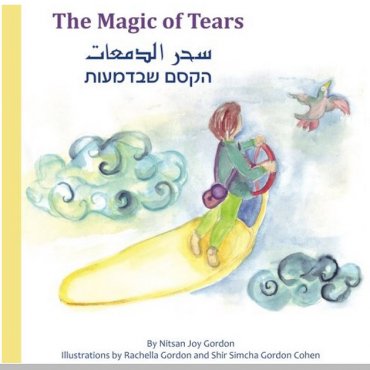
Together Beyond Words
Women on a Quest for Peace in the Middle East
The Israeli-Palestinian region, a Holy Land to many, has been enmeshed in one of the world’s most intractable conflicts for over a century, characterized by prejudice, cycles of failed peace talks and violence.
This is the story of one of the people working to break that cycle. Nitsan Joy Gordon’s life experiences — growing up on a border kibbutz in a country embroiled in conflict, being the only Jew in a high school in the American South, finding the ability to express herself through dance, and more — set her on a 30-year quest to empower women as peacebuilders and transform prejudices between Arabs and Jews, Israelis and Palestinians.
The author is the co-founder of Together Beyond Words, a peacebuilding organization that brings women from both sides of the conflict together using Dance/movement Therapy, Listening Partnerships, Healing Touch, Radical Aliveness (RA) Playback Theater and Internal Family Systems (IFS). In the workshops and meetings old wounds are healed, hidden strength recovered, and emotional understanding and empathy enhanced.
The author and her colleagues believe that our power as women together is no longer dormant and as we liberate ourselves from various degrees of bondage and unite around the world in a call for change, we can also become allies to men in their own liberation of the heart.
“This book and the incredible story it brings to us is so much more than a simple telling; it’s an offering of light and hope. Nitsan joy Gordon’s work is visionary, wise and important. It’s a call for all of us to do the deep healing that must precede a lasting peace. She asks us to live beyond our stories into the heart of love. This is a message for the world.”
PAULA D’ARCY
Writer, retreat leader, conference and seminar speaker.
“In this powerful book, Nitsan Gordon takes us with her on her amazing journey toward bringing healing and peace to the chronic pain and conflict that plague relations among Jews, Arabs, and Palestinians in Israel. Having co-led several Together Beyond Words workshops with her, I can testify to the power of having traditional enemies express their most painful truths and feel witnessed by one another—particularly for Palestinians to feel heard by Jews and watch Jews work on the legacy burdens that drive their racist and oppressive behaviors. Through dance, movement, and psychodramatic techniques, Nitsan creates exceptionally safe spaces for these encounters that are building an important grassroots movement for cross-conflict connection and change. Reading this beautifully written, engaging book, is moving, enlightening, and left me with even more admiration for Nitsan’s courage and persistence.”
RICHARD SCHWARTZ
Ph.D., developer of the Internal Family Systems model (IFS).
“I love this book. It tells the story of a girl, and all the life experiences that led her to become a brave and powerful woman; A woman who was touched by injustice, pain, and bigotry. A woman who could have led a privileged life, a woman who could have not listened to the calling. But a woman who most certainly did. Read this delightful book. Let yourself be inspired. There is so much we can do with this one precious life. Nitsan is a testament to that.”
ANN BRADNEY
CPRA, founder and director of the Radical Aliveness Institute.
Faculty member at Esalen educational institute.
“This inspiring book not only tells the story of one woman’s brave journey from a border kibbutz to a lifelong dedication to peace building; more than that, it gives us a heartening example of what can happen when two visionary change makers – Esalen Institute and Together Beyond Words – combine their creativity in the service of our highest human values.”
NANCY LUNNEY WHEELER
MA, pioneering leader in education for personal and social transformation.
Senior advisor at Esalen educational institute.
“The importance of this book, in my humble opinion, lies in the ability of the author/healer and her colleagues to reach across the boundaries of religious beliefs, ethnicity, skin color and nationality to the essence of our existence as human beings that yearn to live in harmony and peace with one another.”
DR. MARIAM MAR’I
Director of the Akko Arab Women’s Pedagogical Center
“All over the world, nations and communities and cultures are experiencing the pain and destruction that happens when one group demonizes another, when people lose the ability to see the human in each other. But all over the world, people are also transforming trauma and pain into healing and peace. It takes hard work–brave and patient work–to do this, and the Israeli Peace Activist, Nitsan Joy Gordon, has been doing this kind of work for many years. Her new book, Together Beyond Words: Women on a Quest for Peace in the Middle East, is a roadmap for all of us who want to be part of the solution.”
ELIZABETH LESSER
Cofounder of Omega Institute, New York Times
bestselling author of Broken Open, Cassandra Speaks, and other books.

The Magic of Tears Book and Workshop
Shaya is a big boy now and not supposed to cry. But one day, fed up, he opens the door and runs towards the sea. On the way, guided by the wind, he discovers how the pain within his heart can be released and healed through the Magic of Tears. Ultimately, Shaya’s journey also helps his parents re-discover the possibility of crying and opening their hearts.
The 76-page book with 33 water color images illustrates how the healing mechanism of crying works in a story that will touch the hearts of children and adults. It was written and illustrated by a three-generation team. Nitsan (the mother and daughter) wrote the book, Rachella (the grandmother and mother) and Shir (the daughter and granddaughter) illustrated it. All three live in Israel, served in the military or in national service and have experienced the Israeli Palestinian conflict ”up close and personal”.
”I found this book during a quiet lunch break at the library and started reading it. It attracted me visually because it is so colorful and the drawings so beautiful. The story moved me and I began to cry. It touched me exactly in the right places and connected me to the little girl inside, the one who heard so many times in her life that she needs to be strong and that she should not cry and feel sorry for herself. Today as a mother to my own children, I often think about these types of questions and how do I encourage my children to express their feelings? Because I myself find a great deal of comfort in books and draw inner strength from them, I bought a copy for my daughter and nephew. I would like to give them the message that it ”is permitted and desirable to cry”. I want them to know that crying is good for us and that it is nature’s way of supporting us in working through our emotional wounds. Congratulations to Nitsan for her sensitivity in dealing and working with this issue.”
— Yael, the librarian at the Kfar Vradim library
”I have known and admired Nitsan Joy Gordon for fourteen years.
In Nitsan’s capacity as director of Together Beyond Words, our paths have intersected professionally because of our shared passion for furthering world-wide opportunities for women’s empowerment. We have both dedicated our lives and work to helping create bridges for healing, advancement, and peace for humankind.
Nitsan is a visionary, and her lived experience in Israel is a story for the world. The writings she produces in connection with her work are beautifully crafted, passionate, and moving. She herself is an inspiration, and her writing inspires others. These are the stories that need to be told. These are the stories that open hearts and eyes and engage hearts. These are the stories that have the potential to engage the world and inspire change.
Any contribution to Nitsan’s ability to be able to write down her wisdom (and her accompanying call to action) benefits much more than her own life. This is gift to the world: words from the heart of the Middle Eastern struggle, filtered through the heart and soul of one who is living it with insight and awareness. ”
— Paula D’Arcy, a writer, retreat leader, and conference and seminar speaker and the President of the Red Bird Foundation
The workshop will focus both on understanding the natural healing mechanisms we were all born with that include our ability to cry and laugh and on regaining our ability to use these mechanisms. We will teach participants simple exercises that can be used on a daily basis to release painful emotions and reconnect with their hearts. They will learn the art of deep listening as well as movement and noncompetitive games that support the healing process.
Why is crying good for us?…
- It makes nine out of 10 people feel better, reduces stress, and may help to keep the body healthy.
- It’s also free, available to almost everyone, and has no known side effects, other than wet tissues, red eyes and runny makeup.
- Crying may not be a blockbuster drug, but the latest research suggests it’s highly effective at healing, and that it improves the mood of 88.8 per cent of weepers, with only 8.4 per cent feeling worse.
- Researchers suggest that crying is so beneficial that there may be a case for inducing it in those who find it difficult to let go.
Our Article
Nitsan Joy Gordon MA DT, Wafa Zidan M.Sc.
This study examines changes in the attitudes towards sex roles, needs and obligations of Arab women studying early childhood education and changes in emotional awareness of both Arab and Jewish women and men studying education. The intervention experienced by 94 students over the course of one or two semesters is a multidisciplinary approach called Beyond Words. The participants were measured at two points – a week after the beginning of the course and two weeks before its completion and were compared to a control group that did not undergo the intervention. Significant differences were found in the first part of the study dealing with attitudes towards sex roles both in the before and after measures and in comparison with the control group. Women in the experimental group became more confident and more liberal in how they viewed themselves and their ideal role model. The qualitative questionnaire findings clearly advise of the emotional change experienced upon the completion of the course. According to these personal testimonials it seems that the course significantly increased emotional awareness and flexibility in thoughts and feelings as well as acceptance and empathy towards others.
